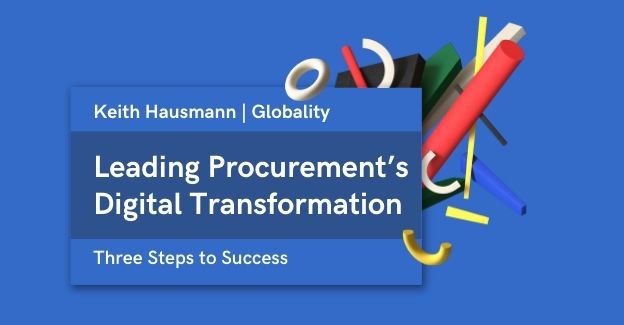As enterprise companies struggle to digitally transform, Globality CRO Keith Hausmann discusses how innovative technology can help procurement meet today’s biggest challenges, while increasing its influence through the power of “Performance Spending.”
In her book Trade wars, pandemics, and chaos: How digital procurement enables business success in a disordered world, Dr. Elouise Epstein, a digital futurist at Kearney, explains why most companies have historically been underwhelmed by the digitalization of procurement processes, noting that it hasn’t always delivered on the promise to empower people to move at speed, be more agile and work how they want.
However, progress has since been made. As Dr. Epstein explains, “Digital procurement technology has evolved, the expectations for leadership regarding digital technology has changed, and the opportunity has arrived for those who are able to seize it.” There is now significant opportunity for procurement to be a crucial driver of enterprise growth and value.
A recent survey Globality conducted, in partnership with SIG, found that only 15% of respondents believe that they are “best-in-class” or “industry leaders” when it comes to the digital transformation of their operating models, and an eye-catching 50% describe themselves as “laggards.” Globality and SIG discussed these findings at an executive virtual roundtable – below are three key takeaways for procurement leaders who want to successfully transform their operating model:
1. Utilize the Power of Performance Spending
Turning the money that procurement spends into an asset to accelerate business performance is a new concept that we at Globality call “Performance Spending.” This approach will enable procurement to become a key driver of enterprise growth and position it firmly at the heart of the business.
Performance spending will help procurement drive improved business performance and impact, whether that is speed to market, agility and resilience during times of disruption, savings, or increased inclusion and sustainability.
A key part of this new idea is helping to enable a company’s ESG strategy. There’s no doubt that ESG is increasingly top-of-mind for investors, CEOs, employees and customers. Procurement can help enterprises hit their targets of increased environmental sustainability, more inclusive economies, greater transparency and stronger corporate governance—all via a global trade ecosystem that is transparent and fair, with greater opportunities for companies of all sizes.
2. Democratize the Procurement Process
Procurement has long talked about the need to democratize the buying process and there is now a clear need to expedite this transformation. Few procurement teams have enough people to actually stay ahead of the business needs of all of their stakeholders across their entire company.
So the question is how do visionary procurement leaders empower users to self-source, but with appropriate guardrails around issues such as risk, preferred suppliers and vetted suppliers?
Traditional buying channels should become new digital self-sourcing processes where we empower and democratize what traditionally was done by the procurement people that teams no longer have enough of, particularly given the current talent shortages in the marketplace.
3. Set Procurement Talent Free
Closely linked to the above is how companies can transform their procurement models, so they are less reliant on humans in the performance of traditional, repetitive procurement tasks, such as running RFPs. Not because humans aren’t capable of doing this, but because there is an increasing shortage of talent on which companies can rely and that talent can be better utilized on more strategic work, such as business partnering and supplier relationship management.
AI technology can help companies deliver better outcomes for many repeatable processes, effectively picking up the burden and freeing up limited human resources. When this happens, procurement talent can focus on more value-driven work. Rather than navigate cumbersome legacy systems, for example, workers can prioritize activities such as problem-solving, supplier collaboration and product development.
Ultimately, as intuitive technology takes routine tasks out of human hands, it’s important for procurement leaders to expand the role of the few team members they do have from being transactional to becoming important innovators within the business. Doing so also opens up the definition of what “procurement talent is” and where people with the required skills can be found (often in other business functions).
Embracing the Future of Procurement
Transformative CPOs and procurement leaders need to articulate a clear vision of the future of procurement – one where they adopt innovative technologies and platforms to either replace outdated analog models and legacy systems, or to enhance and augment installed core systems. Taking this approach, alongside building a team that actively wants to explore new ways of doing procurement to add greater strategic value, will help the broader business gain competitive advantage both today and tomorrow.









